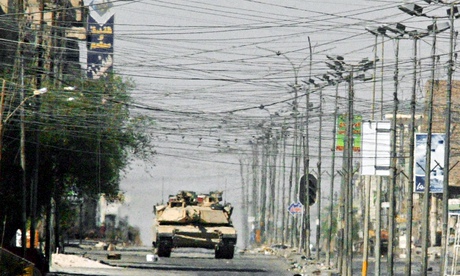US fired depleted uranium at civilian areas in 2003 Iraq war, report finds

US forces fired depleted uranium (DU) weapons at civilian areas and troops in Iraq in breach of official advice meant to prevent unnecessary suffering in conflicts, a report has found.
Coordinates revealing where US jets and tanks fired nearly 10,000 DU rounds in Iraq during the war in 2003 have been obtained by the Dutch peace group Pax. This is the first time that any US DU firing coordinates have been released, despite previous requests by the United Nations Environment Programme and the Iraqi government.
According to PAX’s report, which is due to be published this week, the data shows that many of the DU rounds were fired in or near populated areas of Iraq, including As Samawah, Nasiriyah and Basrah. At least 1,500 rounds were also aimed at troops, the group says.
This conflicts with legal advice from the US Air Force in 1975 suggesting that DU weapons should only be used against hard targets like tanks and armoured vehicles, the report says. This advice, designed to comply with international law by minimising deaths and injuries to urban populations and troops, was largely ignored by US forces, it argues.
A six-page memo by Major James Miles and Will Carroll from the international law division of USAF’s Office of the Judge Advocate General concluded in March 1975 that DU weapons were legal. But it recommended imposing restrictions on how they were used.
“Use of this munition solely against personnel is prohibited if alternative weapons are available,” the memo stated. This was for legal reasons “related to the prohibitions against unnecessary suffering and poison”.
The memo also pointed out that DU weapons were “incendiary” and could have indiscriminate impacts in urban areas. “They may cause fires which spread thereby causing potential risks of disproportionate injury to civilians or damage to civilian objects,” it said. “Precautions to avoid or minimise such risks shall be taken in the use of this weapon or alternate available weapons should be used.”
PAX estimates that there are more than 300 sites in Iraq contaminated by DU, which will cost at least $30m to clean up. DU is a chemically toxic and radioactive heavy metal attractive to weapons designers because it is extremely hard and can pierce armour.
The author of the PAX report, Wim Zwijnenburg, said the US Air Force knew the harm that could be done by DU weapons and should not have used them in populated areas. “The use of DU against these targets questions the adherence of coalition forces to their own principles and guidelines,” he argued. “They should be held accountable for the consequences.”
US forces gave the GPS coordinates of DU rounds, along with a list of targets and the numbers fired, to the Dutch Ministry of Defence, which was concerned about areas in which its troops were stationed last year.
The Dutch MoD then released the data to PAX in response to a request under freedom of information law. The release of the information was a “useful first step towards greater transparency”, said PAX, but the firing coordinates for most DU rounds remain unknown.
More than 300,000 DU rounds are estimated to have been fired during the 2003 Iraq war, the vast majority by US forces. A small fraction were from UK tanks, the coordinates for which were provided to the UN Environment Programme. A further 782,414 DU rounds are believed to have been fired during the earlier conflict in 1991, mostly by US forces.
The Democratic congressman, Jim McDermott, is now urging the US Department of Defence to publish all its DU firing coordinates. “These weapons have had terrible health ramifications for Iraqi civilians,” he said. “The least the US could do is provide the specific targeting data so the Iraqi government can begin the complex clean-up process.”
The US Department of Defence did not respond to a request to comment. One military source was “amazed” that the Dutch government had released sensitive targeting data.



It’s great to read something that’s both enjoyable and provides prmdtaaisgc solutions.